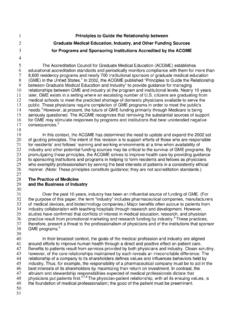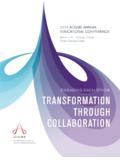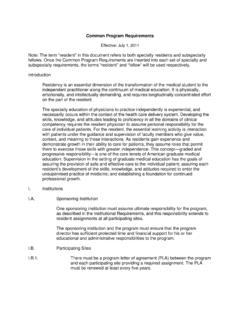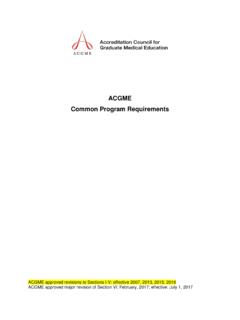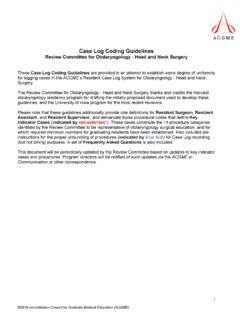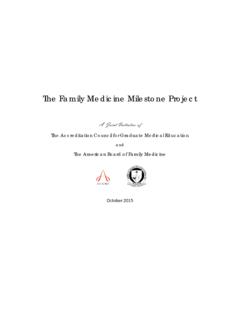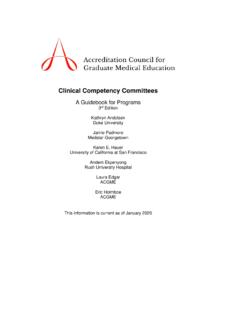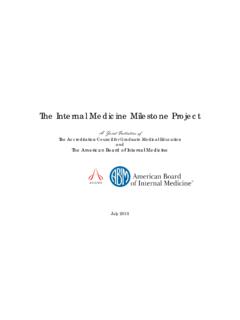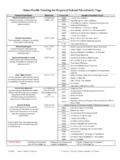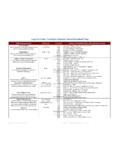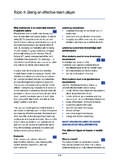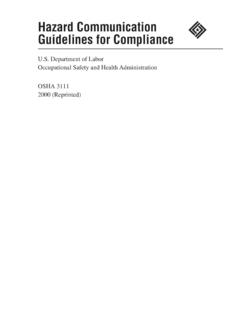Transcription of NATIONAL REPORT OF FINDINGS 20 1 6 ISSUE …
1 Accreditation Council forGraduate Medical EducationCLERC linical LearningEnvironment ReviewNATIONAL REPORT OF FINDINGS 201 6 ISSUE BRIEF No .2 PATIENT SAFETY 2 CLER NATIONAL REPORT of FINDINGS 2016 ISSUE Brief No. 2 Patient SafetyIssue BriefsThe CLER Program presents this series of ISSUE Briefs to supplement the CLER NATIONAL REPORT of FINDINGS ISSUE in the series features one of the focus areas of the CLER Program supplementing the key challenges and opportunities highlighted in the NATIONAL REPORT and enhancing the discussion as to their relevance and potential impact on GME and patient both the NATIONAL REPORT and the ISSUE Briefs, the FINDINGS are based on data collected during the CLER site visits.
2 Including responses to closed-ended questions collected via an audience response system, open-ended structured interviews with the clinical site s executive leaders and leaders in patient safety and health care quality, and information gathered from the many individuals interviewed during walking rounds of the site s clinical ACGME established the CLER Program to provide formative feedback that presents graduate medical education (GME) leaders and the executive leadership of the clinical learning environments (CLEs) for GME with information on six areas of focus: patient safety, health care quality, care transitions, supervision, duty hours/fatigue management and mitigation, and ,2, 3 The CLER NATIONAL REPORT of FINDINGS 20164 presents information from the first set of CLER site visits to participating sites of 297 ACGME-accredited Sponsoring Institutions of residency and fellowship programs.
3 These visits, conducted from September 2012 through March 2015, focused primarily on teaching hospitals, medical centers, and ambulatory sites that host three or more core residency the group sessions conducted during these visits, the CLER teams collectively interviewed more than 1,000 members of executive leadership (including CEOs); 8,755 residents and fellows; 7,740 core faculty members; and 5,599 program directors of ACGME-accredited programs. Additionally, the CLER teams interviewed the CLEs leadership in patient safety and health care quality and thousands of residents and fellows, faculty members, nurses, pharmacists, social workers, and other health care professionals while on walking rounds of the clinical THEMES OF THE NATIONAL REPORT OF FINDINGSThe initial visits of the CLER Program revealed a number of FINDINGS that appeared to be common across many of the CLEs and six focus areas.
4 Clinical learning environments vary in their approach to and capacity for addressing patient safety and health care quality, and the degree to which they engage residents and fellows in these areas. Clinical learning environments vary in their approach to implementing GME. In many clinical learning environments, GME is largely developed and implemented independently of the organization s other areas of strategic planning and focus. Clinical learning environments vary in the extent to which they invest in continually educating, training, and integrating faculty members and program directors in the areas of health care quality, patient safety, and other systems-based initiatives.
5 Clinical learning environments vary in the degree to which they coordinate and implement educational resources across the health care addition to serving as a basis for the overarching themes, the initial CLER visits sought to establish baseline structural and operational characteristics of the clinical sites, as well as their training practices in the six focus areas for residents and fellows. In future cycles, the CLER Program will also seek to understand how the sites identify and prioritize areas for improvement and assess progress over NATIONAL REPORT of FINDINGS 2016 ISSUE Brief No.
6 2 Patient Safety 3 While on walking rounds in a pre-operative area, the CLER site visitor asked a third-year resident if, during his training, he had witnessed any adverse events, near misses, or close calls. The resident responded that he had follow-up, the resident was asked about surgery cancellations due to abnormal laboratory tests for example, high INR levels a test used to assess the risk of bleeding. At this, the resident, rather surprised, stated, I had a patient case canceled this morning for that very reason. Fortunately I caught it in time. He went on to proudly say, On the days that I have surgery, I always come in extra early to double check the lab values, and sometimes re-order tests if a test is missing or I suspect there is a problem.
7 When asked about what happened next, the resident looked a little puzzled. He said, The patient was sent home and told to reschedule she wasn t very happy about it. When asked if he had submitted a patient safety event REPORT , he shook his head and said, No. The CLER site visitor then asked the resident, How often are surgeries canceled at the last minute due to high INR levels? to which the resident responded, It happens all the time; worse yet, sometimes the high INR gets missed and then we can get bleeding problems. A STORY FROM THE FIELDThis story highlights the common lack of a systems approach to identifying and managing patient safety problems that are discovered by well-intentioned individuals.
8 In particular, the resident s response was one of trying harder and being careful rather than reporting to the CLE and working with the organization to identify the underlying systems-based issues and sustainable solutions that would benefit all CLER NATIONAL REPORT of FINDINGS 2016 presents data on four major areas of patient safety: resident and fellow education ; patient safety event reporting; patient safety event review; and the role of the CLE in monitoring/governance around patient safety. This ISSUE brief highlights selected information found in the NATIONAL REPORT , expands upon the FINDINGS in the challenges and opportunities section, and provides a more in-depth look at the four major areas of patient safety in the discussion Safety 4 CLER NATIONAL REPORT of FINDINGS 2016 ISSUE Brief No.
9 2 Patient SafetyFigures 1 and 2 present data based on group interviews with residents and fellows, and together highlight the current range of resident and fellow involvement in addressing patient of CLEsPercent of Residents and Fellows12 010 0806040200 0 20 40 60 80 100 Median = 97 IQR = 92 100 0 20 40 60 80 1006050403020100 Median = 18 IQR = 12 27 Number of CLEsPercent of Residents and FellowsSelected FindingsFigure 1 presents the distribution of CLEs by the percent of residents and fellows within their CLE who reported knowing their clinical site s process for reporting a patient safety event
10 (including a near miss/close call) a median of 2 presents the distribution of CLEs by the percent of residents and fellows within their CLE who reported a near miss/close call of a patient safety event a median of FINDINGS suggest that CLEs are engaged in educational efforts to increase awareness of the issues surrounding patient safety. The next steps, for both GME and CLEs, will be to move from the current state of heightened awareness and knowledge to a collaborative approach that promotes enhanced experiential learning and demonstrated competence in the practices of patient safety and health care quality and the other CLER focus Distribution includes 90% or more of the 297 NATIONAL REPORT of FINDINGS 2016 ISSUE Brief No.
